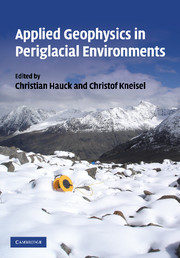Book contents
- Frontmatter
- Contents
- List of contributors
- Introduction
- Part I Geophysical methods
- Part II Case studies
- 5 Typology of vertical electrical soundings for permafrost/ground ice investigation in the forefields of small alpine glaciers
- 6 ERT imaging for frozen ground detection
- 7 Electrical resistivity values of frozen soil from VES and TEM field observations and laboratory experiments
- 8 Results of geophysical surveys on Kasprowy Wierch, the Tatra Mountains, Poland
- 9 Reassessment of DC resistivity in rock glaciers by comparing with P-wave velocity: a case study in the Swiss Alps
- 10 Quantifying the ice content in low-altitude scree slopes using geophysical methods
- 11 The use of GPR in determining talus thickness and talus structure
- 12 GPR soundings of rock glaciers on Svalbard
- 13 Arctic glaciers and ground-penetrating radar. Case study: Stagnation Glacier, Bylot Island, Canada
- 14 Mapping of subglacial topography using GPR for determining subglacial hydraulic conditions
- 15 Snow measurements using GPR: example from Amundsenisen, Svalbard
- 16 Mapping frazil ice conditions in rivers using ground penetrating radar
- Appendix: Tables of geophysical parameters for periglacial environments
- Index
- Plate section
- References
12 - GPR soundings of rock glaciers on Svalbard
Published online by Cambridge University Press: 22 August 2009
- Frontmatter
- Contents
- List of contributors
- Introduction
- Part I Geophysical methods
- Part II Case studies
- 5 Typology of vertical electrical soundings for permafrost/ground ice investigation in the forefields of small alpine glaciers
- 6 ERT imaging for frozen ground detection
- 7 Electrical resistivity values of frozen soil from VES and TEM field observations and laboratory experiments
- 8 Results of geophysical surveys on Kasprowy Wierch, the Tatra Mountains, Poland
- 9 Reassessment of DC resistivity in rock glaciers by comparing with P-wave velocity: a case study in the Swiss Alps
- 10 Quantifying the ice content in low-altitude scree slopes using geophysical methods
- 11 The use of GPR in determining talus thickness and talus structure
- 12 GPR soundings of rock glaciers on Svalbard
- 13 Arctic glaciers and ground-penetrating radar. Case study: Stagnation Glacier, Bylot Island, Canada
- 14 Mapping of subglacial topography using GPR for determining subglacial hydraulic conditions
- 15 Snow measurements using GPR: example from Amundsenisen, Svalbard
- 16 Mapping frazil ice conditions in rivers using ground penetrating radar
- Appendix: Tables of geophysical parameters for periglacial environments
- Index
- Plate section
- References
Summary
Introduction
GPR has been used for rock glacier investigations on the following four sites on Svalbard: Hiorthfjellet rock glacier (78° 15′ N, 15° 47′ E) close to Longyearbyen; four rock glaciers on the northwestern part of Prins Karls Forland (Forlandet) (78° 50′ N, 10° 30′ E); Brøggerbreen rock glacier (78° 54′ N, 11° 53′ E) close to Ny Ålesund; and on Nordenskiöldkysten (77° 53′ N 13° 54′ E). The Hiorthfjellet rock glacier is a typical tongue-shaped, talus-derived rock glacier, which is confined by the large bowl in the Hiorthfjellet mountainside. The Brøggerbreen and Forlandet rock glaciers are lobe-shaped talus-derived rock glaciers situated at the break of slope between the backing rockwall/talus slope and the valley bottom (Brøggerbreen) or strandflat area (Forlandet). On Nordenskiöldkysten, a large, complex talus-derived rock glacier, with a similar setting as those on Forlandet, was investigated.
Methods
All GPR profiles were collected using antennae of 50 MHz centre frequency, aligned perpendicular to the profile direction. Data from the Hiorthfjellet rock glacier were obtained during the winter season in 1997 and followed the central flowline of the Hiorthfjellet rock glacier. The length of the profile was 303 m. The radar used was of the type pulseEKKO 100 (Sensors & Software Inc. Mississauga, Canada). The transmitter/receiver antenna spacing was 2 m. Topographic data from the rock glacier on Hiorthfjellet were obtained from a geodetic survey and a digital altimeter.
- Type
- Chapter
- Information
- Applied Geophysics in Periglacial Environments , pp. 172 - 177Publisher: Cambridge University PressPrint publication year: 2008
References
- 1
- Cited by



